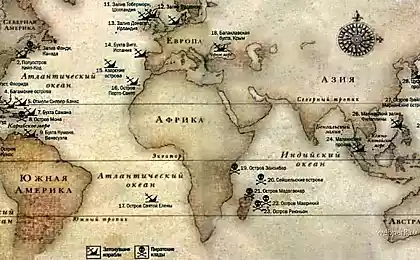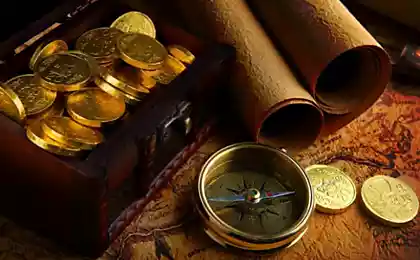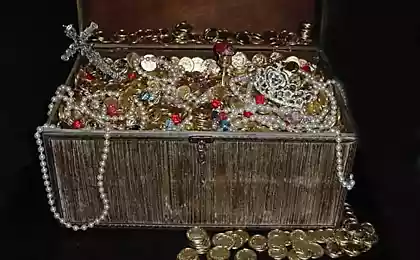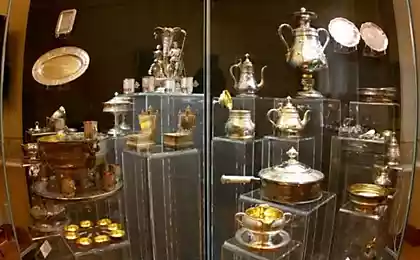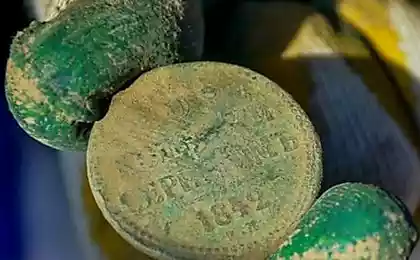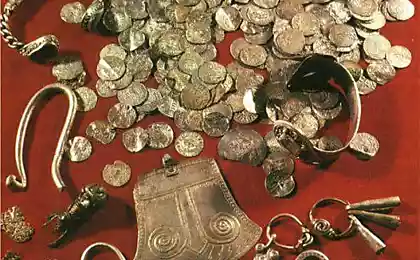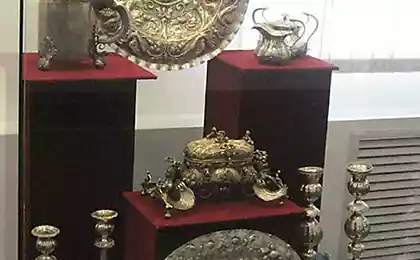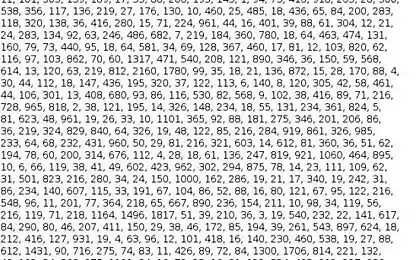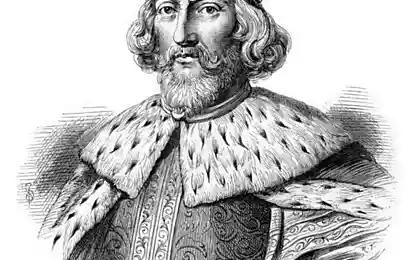926
Treasures and Treasure
World history is shrouded in a variety of puzzles and mysteries. One of the material embodiment of such secrets are hidden treasures and the lost treasure that haunt treasure hunters and archaeologists from around the world. Once these jewels were a source of pride and a testament to the power of their owners, but now these treasures has disappeared, and their whereabouts can only guess.
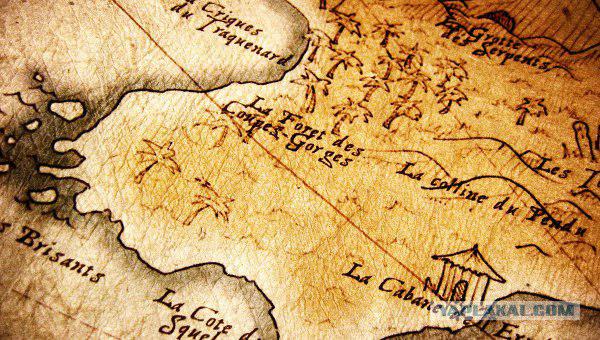
Pirate treasure
Literary works and the film industry is replete with false stories of bloodthirsty pirates and treasures hidden by pirates, are very common in literature and cinema. It is no secret that the prototype for the majority of these images were the real people and destiny.
The most prominent figure in the history of piracy was an English pirate Edward Teach, known as "Blackbeard". Career cruel and ruthless captain lasted only two years, but during this time by a bloodthirsty pirate robberies and looting has managed to accumulate a lot of jewelry.
From 1716, Captain Blackbeard hunted looting Spanish ships, which drove home the gold from South America and Mexico. It was not until the autumn of 1718, when Thich and his team were defeated in boarding combat a crew of British Lieutenant Robert Maynard. Edward Teach received five fatal gunshot and stab wounds 20. Maynard Tichu cut off his head and ordered her to hang from the yardarm of his vessel. The surviving pirates were executed by hanging.
What happened to the treasures that had Thich loot with his team, to this day it remains a mystery. The historical archives contain records that a pirate said that he hid the treasure. However, he did not leave anything that could help in the search for jewels. However, this does not stop many hunters, trying to assign a pirate gold.
Sunken ship captain flagship Edward Teach "Queen Anne's Revenge» (Queen Anne's Revenge) was discovered in 1996 off the coast of North Carolina, where he held his last battle boarding. Unfortunately, on board did not have anything valuable. Among the other places where the treasure can be Edward Teach - Caribbean islands, caves in the Cayman Islands and the Chesapeake Bay on the US east coast.
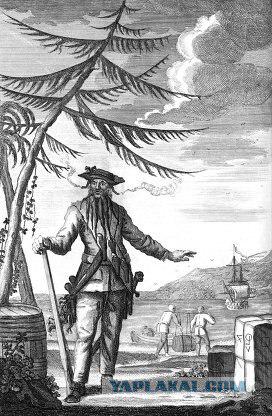
No less notorious enjoyed a native of Wales, a pirate named Henry Morgan, who lived from 1635 till 1688 year. Legendary captain hid more than one treasure. It is known that Morgan repeatedly as Teach, visited the Cayman Islands, located to the north-west of Jamaica. Chances are, that's where he could bury part of the stolen jewels. In addition, Morgan has repeatedly found refuge on the Isle of Pines (Isla de la Juventud), located 65 kilometers south of the coast of Cuba and, as two drops of water similar to the Treasure Island of the famous novel by Stevenson. The researchers admit that there could hide the leader of the pirates of the loot.
Map real-life treasure and treasures that have not yet found
In 1997, two former American soldier who served at one time in the Canal Zone, returned to Panama. In the cave at the Chagres River, approximately 40 kilometers north of Fort Clayton, they found a treasure buried in the XVII century, allegedly by Henry Morgan. Ironically, find treasure colleagues helped an old pirate map, purchased from the merchant market. Besides gold doubloons, the cache was full of gold and silver jewelry.
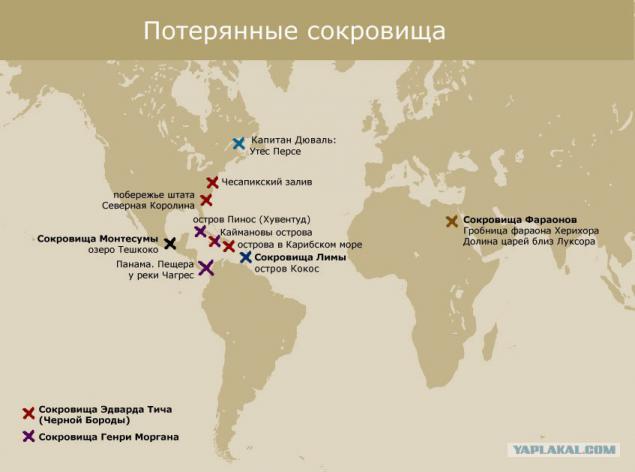
Captain Duval is not as well known as Captain Teach or Henry Morgan, but his name is firmly established in the history of piracy due to the extraordinary ingenuity with which he has, pripryatyvaya stolen wealth.
Name Captain Duval connected from the cliff Perse, located on the east coast of Canada, in the Strait of Saint-Laurent. According to legend, when British warships blocked sloop Duval at the Gaspé Peninsula, the captain, preparing to escape, I decided how to reliably hide stolen treasures.
Explorer-Indian pirates showed how to get to a small platform on a cliff near vysivsheysya. One of the sailors climbed the rope up, with ropes pulled treasure chest and hid it in a hole. To ensure its treasures even greater safety, Duval ordered to blow up the rock powder keg. Along with the explosion of rock collapsed and a big chunk of the cliff, creating an irresistible protrusion attempts to climb on that later cost the lives of many climbers.
Perce really impregnable. On three sides it is surrounded by reefs and rocks that cover the approach to the cliff. On the fourth - a vertical wall, closer to the apex turning into a huge overhanging ledge above the water. Dozens of brave souls have tried to climb it, but were forced to retreat. Because of the strong wind down the cliff from the helicopter as it seems impossible.

There were some pirates who are not selected jewels force, and received their deception went into the trust. In 1820, the city of Lima in Peru was on the verge of revolution. Fearing for the safety of valuables that were in the city, the authorities decided to move to Mexico all the wealth that included precious stones, gold, in particular, two statues of the Virgin Mary, made of pure gold the size of a man's height. Responsible for transport was appointed captain William Thompson. Thompson, however, entrust valuable cargo was a fatal mistake, because it turned out to be a real pirate.
As soon as the ships sailed into the open sea, the captain and his men were massacred by these guards, and headed for the Cocos Island, located in the equatorial Pacific Ocean, 500 kilometers off the coast of Costa Rica. Historians believe that this island was a treasure hidden away with untold wealth.
From the middle of the XIX century on Cocos Island with the purpose to find the treasure, it was outfitted more than 300 expeditions. In the period from 1935 to 1940 on the island of three visits US President Franklin Roosevelt. Security and aides izlazali length and breadth of the island, but their searches were unsuccessful. According to various estimates, the total value of the treasures that can be found on the island of Cocos, from 12 to 60 million dollars. Treasures of ancient civilizations
In 1922, British archaeologist Howard Carter discovered in the Egyptian Valley of the Kings near Luxor tomb of Tutankhamun. Along with the body of the pharaoh researcher found a lot of jewelry. To completely rewrite the valuable items, Carter took about ten years.
We can say that it was a unique find, since most of the tombs of Egyptian pharaohs, discovered earlier, is completely empty. It is still unknown where the lost treasure that must have been in the tombs of pharaohs. First of all, suspicion falls on looting tombs, which for centuries encroached on the contents of Egyptian tombs. Nevertheless, the number of graves is too large to someone could completely devastate them, without leaving any traces.
Some researchers believe that the treasures were lost in the period of the reign of 20 and 21 Egyptian dynasties (425-343 BC), when carried out in the Valley of the Kings Pharaonic reburial.
Of particular interest is also the activity of Pharaoh Herhor (c. 1091-1084 BC), who came to power, headed reinterments procedures. It is possible that taking advantage of its status, the pharaoh had stolen a large piece of jewelry, which were placed in the tomb along with the bodies of the pharaohs. Tomb Herhor still not been found, so the historians and archaeologists have every reason to believe that the missing treasures are found in the place of his burial.
Not less questions causes and location of the treasure of Montezuma. Moctezuma II was the emperor of the Aztecs from 1503. In 1520, the Spanish conquistadors led by Hernan Cortes entered the city of Tenochtitlan (located on the site of modern Mexico City), where he was Montezuma. Plundering and pillaging every home, the invaders captured the Aztec ruler. Montezuma appealed to his people to obey conquistadors. In response, the Indians and the Spaniards took up arms, and their emperor. It started an armed uprising. Army Cortez could not stand the onslaught of the Aztecs. Montezuma was killed under mysterious circumstances, and part of the Cortes and his army managed to leave the city by flight, although they were forced to leave all the gold stolen in Tenochtitlan.
A year later, Cortes again attempted to capture Tenochtitlan and return the treasures. But by the time the Spanish army reached the town, the remains of Indians hidden treasure, presumably, in the area of Lake Texcoco. For five centuries, gold hunters vainly exploring the neighborhood of Mexico City in search of the missing jewelry and gemstones.
Source - RIA news

Councils who found the treasure.

Source:

Pirate treasure
Literary works and the film industry is replete with false stories of bloodthirsty pirates and treasures hidden by pirates, are very common in literature and cinema. It is no secret that the prototype for the majority of these images were the real people and destiny.
The most prominent figure in the history of piracy was an English pirate Edward Teach, known as "Blackbeard". Career cruel and ruthless captain lasted only two years, but during this time by a bloodthirsty pirate robberies and looting has managed to accumulate a lot of jewelry.
From 1716, Captain Blackbeard hunted looting Spanish ships, which drove home the gold from South America and Mexico. It was not until the autumn of 1718, when Thich and his team were defeated in boarding combat a crew of British Lieutenant Robert Maynard. Edward Teach received five fatal gunshot and stab wounds 20. Maynard Tichu cut off his head and ordered her to hang from the yardarm of his vessel. The surviving pirates were executed by hanging.
What happened to the treasures that had Thich loot with his team, to this day it remains a mystery. The historical archives contain records that a pirate said that he hid the treasure. However, he did not leave anything that could help in the search for jewels. However, this does not stop many hunters, trying to assign a pirate gold.
Sunken ship captain flagship Edward Teach "Queen Anne's Revenge» (Queen Anne's Revenge) was discovered in 1996 off the coast of North Carolina, where he held his last battle boarding. Unfortunately, on board did not have anything valuable. Among the other places where the treasure can be Edward Teach - Caribbean islands, caves in the Cayman Islands and the Chesapeake Bay on the US east coast.

No less notorious enjoyed a native of Wales, a pirate named Henry Morgan, who lived from 1635 till 1688 year. Legendary captain hid more than one treasure. It is known that Morgan repeatedly as Teach, visited the Cayman Islands, located to the north-west of Jamaica. Chances are, that's where he could bury part of the stolen jewels. In addition, Morgan has repeatedly found refuge on the Isle of Pines (Isla de la Juventud), located 65 kilometers south of the coast of Cuba and, as two drops of water similar to the Treasure Island of the famous novel by Stevenson. The researchers admit that there could hide the leader of the pirates of the loot.
Map real-life treasure and treasures that have not yet found
In 1997, two former American soldier who served at one time in the Canal Zone, returned to Panama. In the cave at the Chagres River, approximately 40 kilometers north of Fort Clayton, they found a treasure buried in the XVII century, allegedly by Henry Morgan. Ironically, find treasure colleagues helped an old pirate map, purchased from the merchant market. Besides gold doubloons, the cache was full of gold and silver jewelry.

Captain Duval is not as well known as Captain Teach or Henry Morgan, but his name is firmly established in the history of piracy due to the extraordinary ingenuity with which he has, pripryatyvaya stolen wealth.
Name Captain Duval connected from the cliff Perse, located on the east coast of Canada, in the Strait of Saint-Laurent. According to legend, when British warships blocked sloop Duval at the Gaspé Peninsula, the captain, preparing to escape, I decided how to reliably hide stolen treasures.
Explorer-Indian pirates showed how to get to a small platform on a cliff near vysivsheysya. One of the sailors climbed the rope up, with ropes pulled treasure chest and hid it in a hole. To ensure its treasures even greater safety, Duval ordered to blow up the rock powder keg. Along with the explosion of rock collapsed and a big chunk of the cliff, creating an irresistible protrusion attempts to climb on that later cost the lives of many climbers.
Perce really impregnable. On three sides it is surrounded by reefs and rocks that cover the approach to the cliff. On the fourth - a vertical wall, closer to the apex turning into a huge overhanging ledge above the water. Dozens of brave souls have tried to climb it, but were forced to retreat. Because of the strong wind down the cliff from the helicopter as it seems impossible.

There were some pirates who are not selected jewels force, and received their deception went into the trust. In 1820, the city of Lima in Peru was on the verge of revolution. Fearing for the safety of valuables that were in the city, the authorities decided to move to Mexico all the wealth that included precious stones, gold, in particular, two statues of the Virgin Mary, made of pure gold the size of a man's height. Responsible for transport was appointed captain William Thompson. Thompson, however, entrust valuable cargo was a fatal mistake, because it turned out to be a real pirate.
As soon as the ships sailed into the open sea, the captain and his men were massacred by these guards, and headed for the Cocos Island, located in the equatorial Pacific Ocean, 500 kilometers off the coast of Costa Rica. Historians believe that this island was a treasure hidden away with untold wealth.
From the middle of the XIX century on Cocos Island with the purpose to find the treasure, it was outfitted more than 300 expeditions. In the period from 1935 to 1940 on the island of three visits US President Franklin Roosevelt. Security and aides izlazali length and breadth of the island, but their searches were unsuccessful. According to various estimates, the total value of the treasures that can be found on the island of Cocos, from 12 to 60 million dollars. Treasures of ancient civilizations
In 1922, British archaeologist Howard Carter discovered in the Egyptian Valley of the Kings near Luxor tomb of Tutankhamun. Along with the body of the pharaoh researcher found a lot of jewelry. To completely rewrite the valuable items, Carter took about ten years.
We can say that it was a unique find, since most of the tombs of Egyptian pharaohs, discovered earlier, is completely empty. It is still unknown where the lost treasure that must have been in the tombs of pharaohs. First of all, suspicion falls on looting tombs, which for centuries encroached on the contents of Egyptian tombs. Nevertheless, the number of graves is too large to someone could completely devastate them, without leaving any traces.
Some researchers believe that the treasures were lost in the period of the reign of 20 and 21 Egyptian dynasties (425-343 BC), when carried out in the Valley of the Kings Pharaonic reburial.
Of particular interest is also the activity of Pharaoh Herhor (c. 1091-1084 BC), who came to power, headed reinterments procedures. It is possible that taking advantage of its status, the pharaoh had stolen a large piece of jewelry, which were placed in the tomb along with the bodies of the pharaohs. Tomb Herhor still not been found, so the historians and archaeologists have every reason to believe that the missing treasures are found in the place of his burial.
Not less questions causes and location of the treasure of Montezuma. Moctezuma II was the emperor of the Aztecs from 1503. In 1520, the Spanish conquistadors led by Hernan Cortes entered the city of Tenochtitlan (located on the site of modern Mexico City), where he was Montezuma. Plundering and pillaging every home, the invaders captured the Aztec ruler. Montezuma appealed to his people to obey conquistadors. In response, the Indians and the Spaniards took up arms, and their emperor. It started an armed uprising. Army Cortez could not stand the onslaught of the Aztecs. Montezuma was killed under mysterious circumstances, and part of the Cortes and his army managed to leave the city by flight, although they were forced to leave all the gold stolen in Tenochtitlan.
A year later, Cortes again attempted to capture Tenochtitlan and return the treasures. But by the time the Spanish army reached the town, the remains of Indians hidden treasure, presumably, in the area of Lake Texcoco. For five centuries, gold hunters vainly exploring the neighborhood of Mexico City in search of the missing jewelry and gemstones.
Source - RIA news

Councils who found the treasure.

Source:
